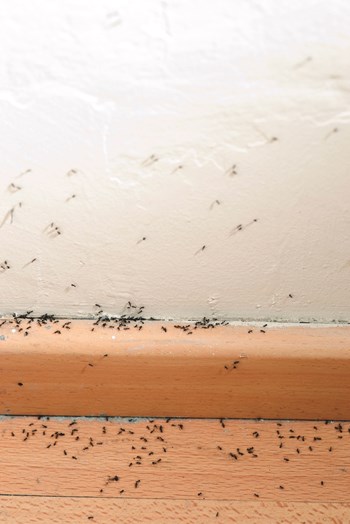
It’s a common scene on a New York street. A woman dressed in head-to-toe black is walking down the street, chatting on her phone. A rat the size of a small cat appears from behind a garbage can and wanders right across the woman's path; her gait doesn’t even waver as she takes a giant leap to avoid tripping over or stepping on the unafraid rodent.
“Rats have grown accustomed to New Yorkers, and they’re not even scared of them anymore,” says Nana Kojo Ayesu, owner of Kojo’s Pest Elimination Company LLC, based in the Bronx.
When the topic of pests in New York City comes up, rats, roaches and sometimes even pigeons are likely the first critters to leap to mind for most people. But New York City covers a lot of territory and different parts of the city harbor different pests. And they all seem as forthcoming as New Yorkers themselves, crawling and scampering right into condos, co-ops, townhomes and houses to make themselves right at home. It’s time to seize the day and to kick those critters out. But how? It depends on the season and the critter but we’ve grilled some of the Big Apple's professional exterminators to get their secrets.
Who Goes There?
The first step is to figure out who is lurking in your home, says Arthur Katz, president of Knockout Pest Control in Uniondale. Homeowners on the 23rd floor in Manhattan won't usually have to worry about bees, termites or carpenter ants invading their abode, for example, Katz says. “Those come from structural problems, and they won’t be in apartments,” but everyone living in New York City will have to be on high alert for roaches, water bugs, mice, bed bugs and carpet beetles.
Still, if there were a competition among vermin to find the most universally present pest critter, rodents would win—they’re anywhere and everywhere, Ayesu says. “The major pest problems I find in New York City are rodents, followed by bed bugs, followed by roaches.” High-rise dwellers may have fewer problems than those in private homes, but their issues may be more challenging because of the propensity of these critters to travel from one home to another.
And if furry vermin weren't enough of a headache, according to Katz, we’re in the middle of termite season. “We’re getting hundreds of calls for carpenter ants, pavement ants, bees and wasps” in private homes, he says. “Our schedule is full of those.”
And if you’ve noticed more ants than ever this year, you’re not imagining it, says Jeffrey Dworkin, president of Ecology Exterminating in Brooklyn. “Ants are very strong this year because we had a longer, colder winter,” he says. “Now that the summer is finally here, they’re all over the place because they feed on nectar, and it is creating a big, big ant problem.”
Ants are a problem for everyone regardless of whether you live in a high rise in Manhattan to whether you live in a house in New Jersey. They contaminate foods, infest structures and build ugly mounds in lawns, Dworkin says. Carpenter ants—the largest species in the region—can very in color from black to red or yellow. You can find them under household insulation, in wall voids, doorframes, window frames, near tree holes or under attic eaves. There has even been an influx of a nasty subspecies of ant that was blown into town in the wake of Hurricane Sandy and appears to have stuck around. An expert came to debrief Katz's crew on the newcomer; according to him, the ant's sting causes pain and lingering swelling for those unlucky enough to meet one.
Not Very Mice
While ants are in high gear at the moment, that other scourge—the mice are never far away. According to Dworkin, mice are more prominent in colder weather because they take shelter inside the buildings.
If you think you’re living in a mice-free building, think again, says Louis Taranto, owner of Tonto Pest Control, based in Brooklyn. You simply may not see the mice, but they’re there, behind the walls.“Mice are in 80 to 90 percent of the buildings,” he says. “When you turn the heat on, the pipes hurt their feet, and when they get hot-foot, they come into apartments.” That’s why more mice invade New York City apartments in the fall and in the winter, and why they leave in the spring and in the summer seasons, Taranto says.
One type of bug that’s always active regardless of the season is the bedbug.
“People might think that bedbugs have gone away because the media has stopped talking about them but they're as abundant now as they’ve ever been,” Katz says.
Ayesu agrees, and adds that bedbugs are opportunistic critters, positioning themselves wherever there's the most traffic, and therefore the most opportunities to make a meal.“If there are a lot of holes, they can go from one apartment to another,” he says. “If there’s a theater, a subway, a bus, a plane, other people’s apartments, restaurants—anywhere where people are going to sit for a while and may not feel the bedbugs—that’s where they’ll be.”
And the general bug scene is getting even worse for New Yorkers. Another new arrival on the scene is the stinkbug.“They look like a shield,” Dworkin says, “and they attach to the sides of buildings and climb into any openings.”
While stinkbugs, even lots of them, won’t do any damage to you or to your home, they will do damage to your sense of smell if you squish them, because—as their name would suggest—they literally let off a terrible odor when they die. Instead of smashing the bugs, Dworkin suggests picking them up with tissue paper and flushing them down the toilet so you won’t be subjected to their stench.
Bug Beaters
Fortunately, there are many ways to conquer bugs—many of which are leaps and bounds ahead of their harsher, less environmentally-friendly predecessors—and pest control pros are on board to help boards, managers, and residents keep their properties vermin-free.
For example, all the products Katz’s company uses are non-lethal to people; he chooses only to use products that are lethal to bugs—including one for termite eradication that most people still don’t know about or use frequently. It’s called Sentricon, and his company was one of the first to use it in New York. Katz says the eco-friendly solution is anything but friendly to termites—it kills nearly 100% of them.
The resident should also take some responsibility by keeping his home nice and clean, Dworkin says. “Extermination is no substitute for sanitation,” he says.
Still, there’s one way to get rid of pests without murdering them and cleaning your home from top to bottom—and that’s by preventing them from entering your house in the first place, Taranto says.
“You have to do what you can do to seal your apartment,” he says.
The pest management company can close the holes and they can caulk the cracks and the crevices so you can reduce the dependence on chemicals by relying on prevention, Dworkin says.
Instead of consulting with a basic contractor to do the work, however, Taranto says to stick with an exterminator to do this job.
“Just because a contractor says he closed a hole doesn’t mean that it’s rodent-proof. We’re more keen to rodent-proofing,” he says.
However, before you let just anyone kill and protect your home from your bugs, make sure they’re properly accredited to get the job done correctly.
Katz’s team is Quality Pro and Green Pro, and fewer than 1 percent of the companies in the country get that affiliation, he says.
“We promise to not only do our work according to the highest standards of the state, but we go well above and beyond that,” Katz says. “We’re drug-free, we do criminal background checks, and our employees have to go through three levels of certification.”
His team also gets certified through the state via the National Pest Management Association.
At the very least, Ayesu recommends that the exterminator hold a 7A and 7F certification from the New York State Department of Environmental Protection Bureau of Pesticides.
Now here’s the tricky part. You’ve got bugs. Your whole apartment is a critter-mess and you’ve spotted more than a few mice shacking up under your bed.
Is this your responsibility? Does the board call the exterminator? Should the management company pick up the phone?
Dworkin says he’s typically hired by the management company to do the public areas such as the basement, hallways and common rooms.
“It depends on how the co-op or condo structure is set,” Dworkin says.
In some condo buildings, each unit is responsible for their own unit, so they would have to pay for their area. More typically, however, he says, in all residential buildings, the management company pays for everything. New York City recently passed a local law with regard to pest control saying that the building needs to be diligent with bed bugs, Taranto says. In a rental building, the landlord is responsible for any bedbug issue—even if the tenant was the person who brought the bedbugs into the unit via his bed. Therefore, it’s recommended that when the rental unit is vacant, that a licensed pest control company inspect it and verify that it’s bed free. They should issue a certification stating so.
In New York, you’re required to disclose a 1-year history of bed bug status to potential renters, but if you’ve had bed bugs in the past year but have gotten rid of the issue, you can use the certification from the pest control company to try to convince the potential renters that the unit is now safe.
When the tenant signs the lease, they also should sign an addendum showing that they received the certification and saw that the unit was bug-free when they moved into the unit.
While the occasional marauding mouse or pesky pigeon may be dealt with by your building's engineer or maintenance person, it's important that your building or HOA have a competent, knowledgeable, properly accredited pest control expert on the team to address anything more serious. The field of pest control and eradication have come a very long way since the days when Raid and a flyswatter were the most sophisticated tools to be had.
Danielle Braff is a freelance writer and a frequent contributor to The Cooperator.






Leave a Comment